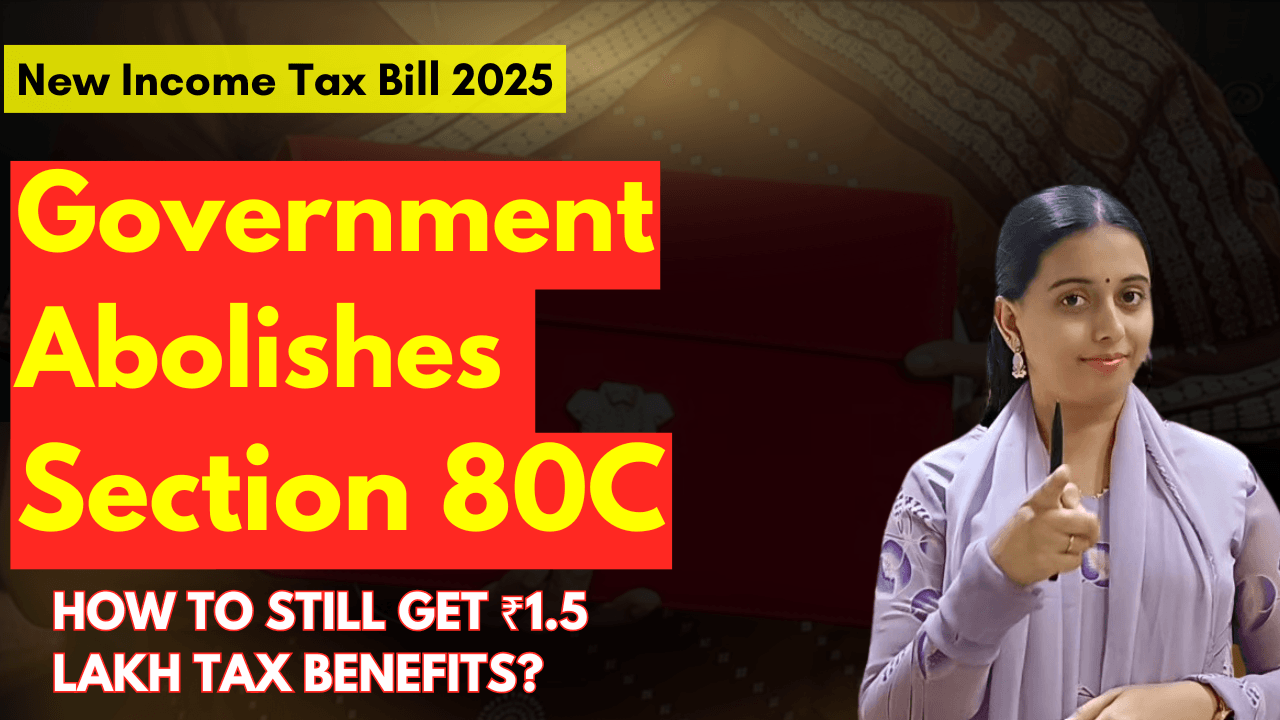Government Abolishes Section 80C
Government Abolishes Section 80C The Indian government has proposed a major change in the Income Tax Act that has taken taxpayers by surprise. Section 80C, one of the most widely used tax-saving provisions, has been abolished under the new Income Tax Bill 2025. This section allowed taxpayers to claim deductions of up to ₹1.5 lakh on various investments and expenses, reducing their taxable income.
Now, after its removal, taxpayers must explore new ways to save taxes. Let’s understand what this means and how taxpayers can continue to get similar benefits under the new tax rules.
What Does the New Proposal Say?
Finance Minister Nirmala Sitharaman has introduced a new proposal in Parliament aimed at simplifying income tax rules. The proposed changes include:
✅ Abolition of Section 80C under the new tax system.
✅ Introduction of Section 123, which will include some of the benefits of 80C.
✅ Changes in income tax slabs, making tax filing easier.
Currently, the bill is under review, and once passed, it will become a new tax law. Government Abolishes Section 80C There is significant debate on how this will impact taxpayers, especially those who heavily relied on Section 80C investments to reduce their taxable income.
How Did Section 80C Help Taxpayers?
Under the old tax system, taxpayers could claim deductions of up to ₹1.5 lakh under Section 80C by investing in:
✔️ Equity-Linked Savings Scheme (ELSS) – A mutual fund scheme with tax benefits.
✔️ Public Provident Fund (PPF) – A long-term savings scheme with guaranteed returns.
✔️ Life Insurance Premiums – Premiums paid for life insurance policies.
✔️ National Pension System (NPS) – A retirement savings plan.
✔️ Tax-Saving Fixed Deposits (FDs) – Bank deposits with a 5-year lock-in period.
✔️ Employee Provident Fund (EPF) – Contributions made towards employees’ retirement.
✔️ Sukanya Samriddhi Yojana (SSY) – A savings scheme for the girl child.
This provision allowed salaried employees, self-employed individuals, and Hindu Undivided Families (HUFs) to reduce their tax liability and encourage savings.
New Tax Rules: Introduction of Section 123
The government has not entirely removed the benefits of Section 80C. Instead, it has restructured tax-saving provisions under Section 123. The key highlights are:
🔹 Deductions of up to ₹1.5 lakh will still be available.
🔹 Only specific investments will be eligible for deductions under Section 123.
🔹 Salaried individuals and HUFs can continue to claim tax benefits.
🔹 Simplified claim process compared to Section 80C.
However, the list of eligible investments under Section 123 is still being finalized. Government Abolishes Section 80C Taxpayers must wait for official guidelines to know whether all previous 80C investments will be covered under the new rule.
How to Still Get ₹1.5 Lakh Tax Benefits?
Since Section 80C is being phased out, here are alternative ways taxpayers can continue to save on taxes:
- Utilize Section 123 Benefits
If Section 123 includes PPF, ELSS, NPS, and life insurance, taxpayers can continue using these investment options to claim deductions up to ₹1.5 lakh.
- Increase Contribution to NPS (Section 80CCD)
Even after Section 80C’s removal, Section 80CCD(1B) allows an additional deduction of ₹50,000 for contributions to NPS. This can increase total deductions beyond ₹1.5 lakh.
- Opt for Home Loan Interest Deduction (Section 24b)
Taxpayers can claim up to ₹2 lakh in deductions for home loan interest payments under Section 24(b). This remains a great way to save taxes.
- Health Insurance Benefits (Section 80D)
Medical insurance premiums paid for self and family can still be deducted under Section 80D:
- ₹25,000 for individuals below 60 years.
- ₹50,000 for senior citizens.
- Education Loan Deduction (Section 80E)
Taxpayers repaying education loans for higher studies can claim interest deductions under Section 80E without any upper limit.
- House Rent Allowance (HRA) for Salaried Individuals
Salaried employees living in rented houses can claim HRA tax benefits, reducing taxable income.
Impact on Taxpayers: Who Wins & Who Loses?
✅ Who Benefits?
- Taxpayers who already opted for the new tax regime (which does not allow 80C benefits) will not be affected.
- Those investing in NPS, home loans, or health insurance can still claim deductions.
❌ Who Will Face Challenges?
- Salaried individuals and HUFs who heavily relied on 80C investments will have to adjust their tax-saving strategies.
- Taxpayers preferring PPF, ELSS, or tax-saving FDs must check whether these investments will be covered under Section 123.
Conclusion: What Should Taxpayers Do Next?
1️⃣ Wait for Official Notification – The new Income Tax Bill 2025 is under review, and more clarity on Section 123 eligibility will come soon. Government Abolishes Section 80C
2️⃣ Plan Alternative Investments – If Section 80C investments are no longer available, explore NPS, health insurance, home loans, and education loans for tax savings.
3️⃣ Consult a Tax Expert – Before making financial decisions, consult with a tax advisor to optimize your tax-saving strategy.
The abolition of Section 80C is a major shift in India’s tax landscape. While some benefits continue under Section 123, taxpayers must stay updated and adapt their investment and tax planning strategies to minimize tax liability.
👉 What are your thoughts on this big change? Do you think Section 123 will be as beneficial as 80C? Share your views in the comments!
Sources Link – https://shorturl.at/r65pE
For More Information : https://taxgyany.com/

